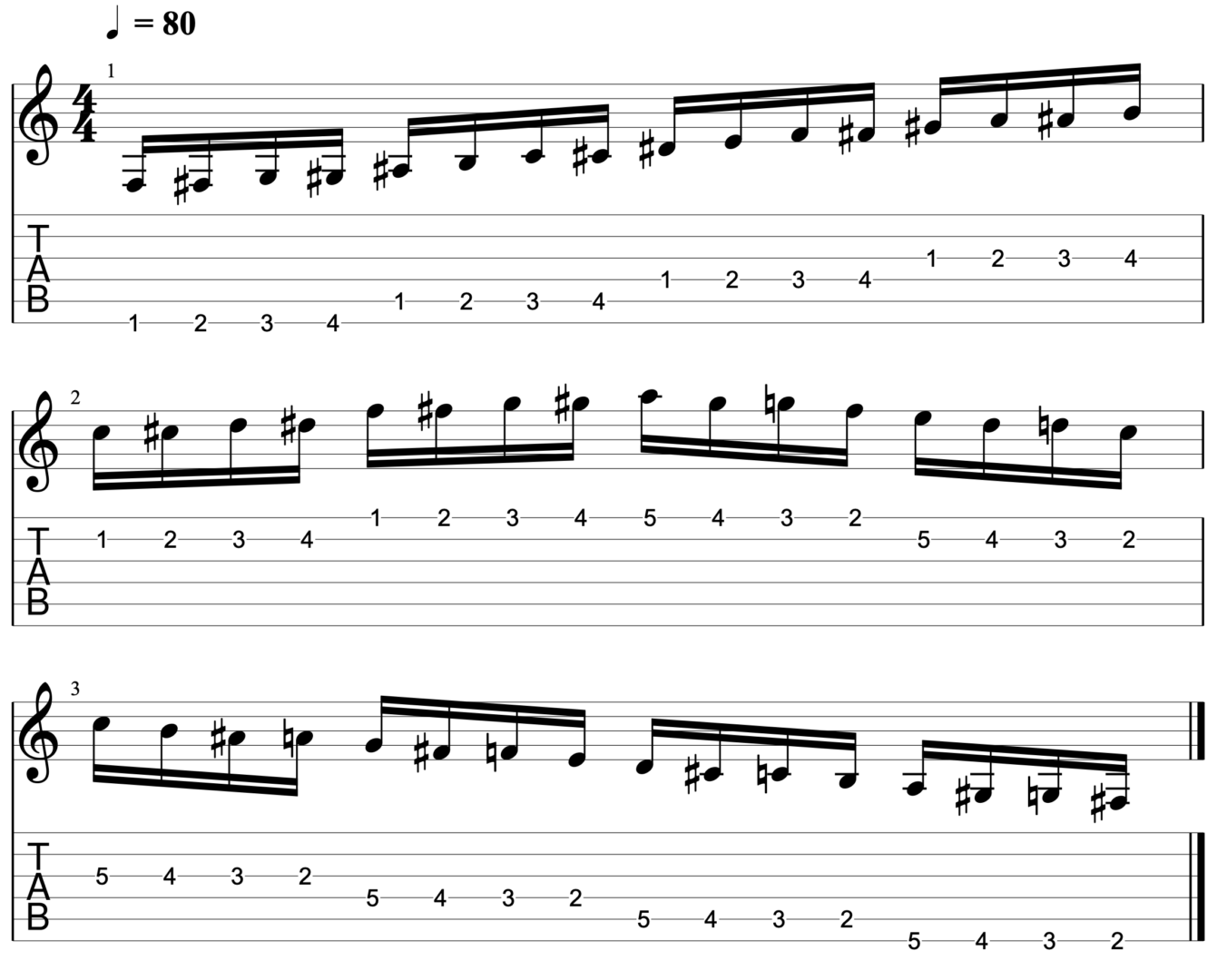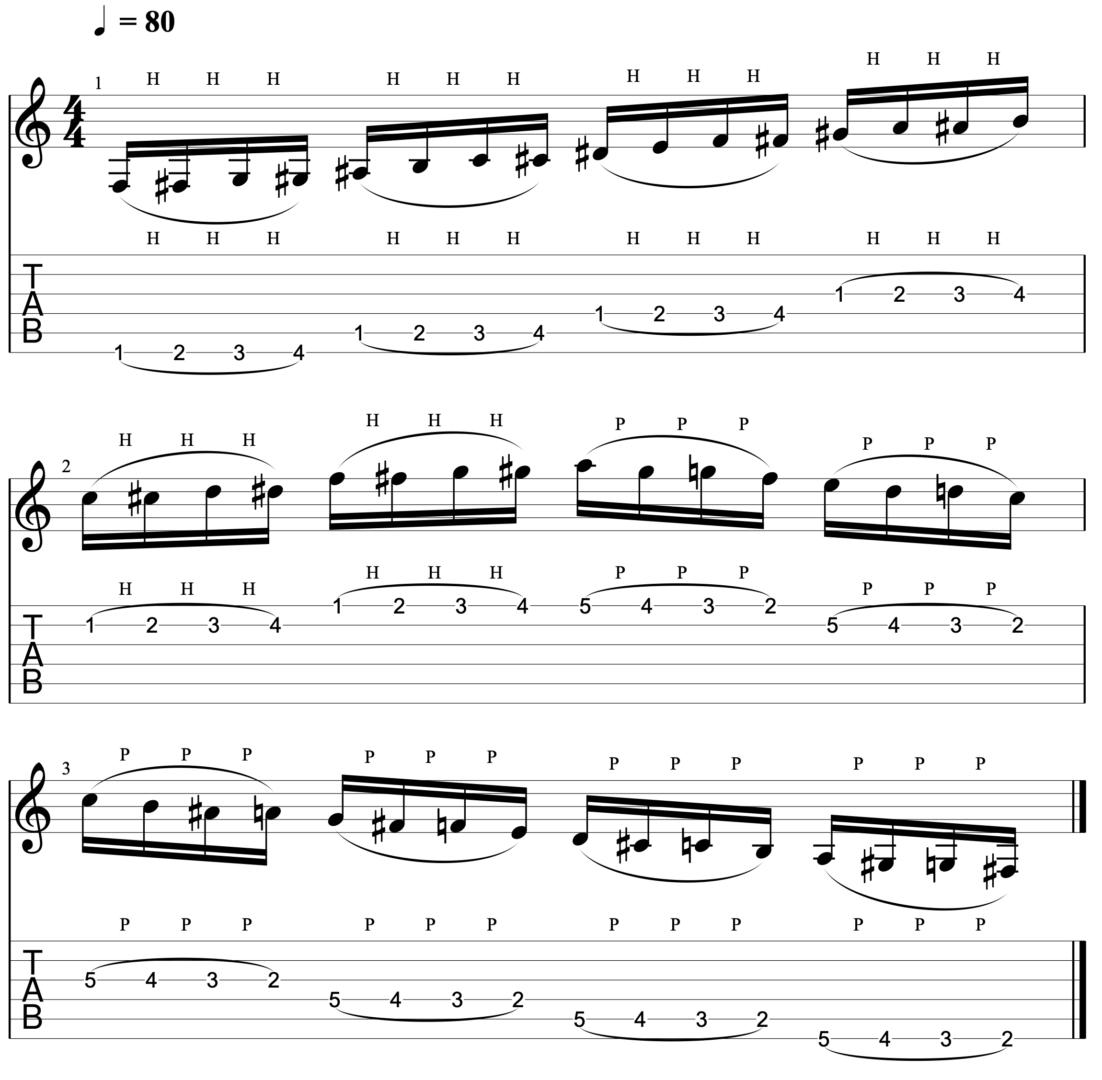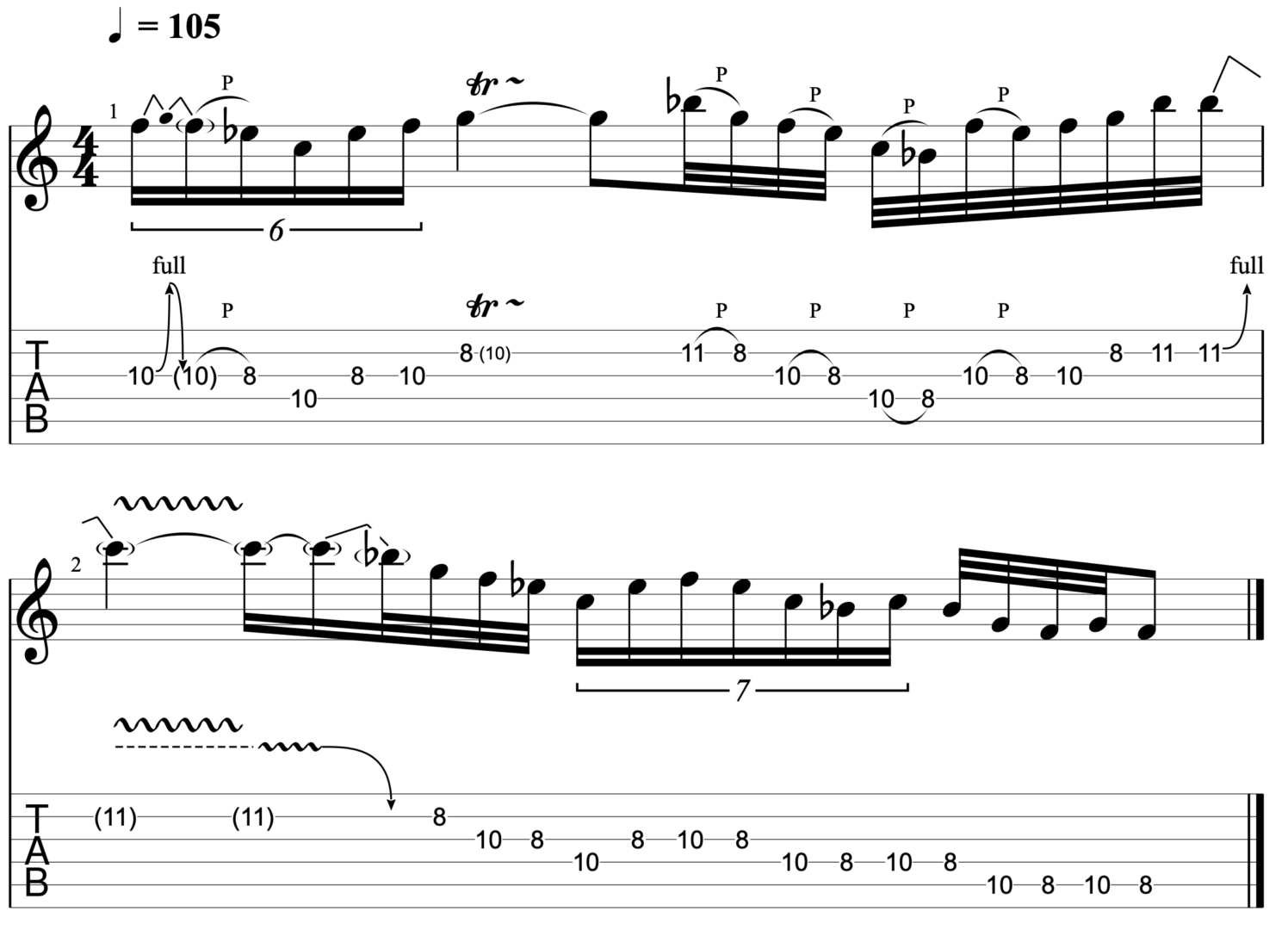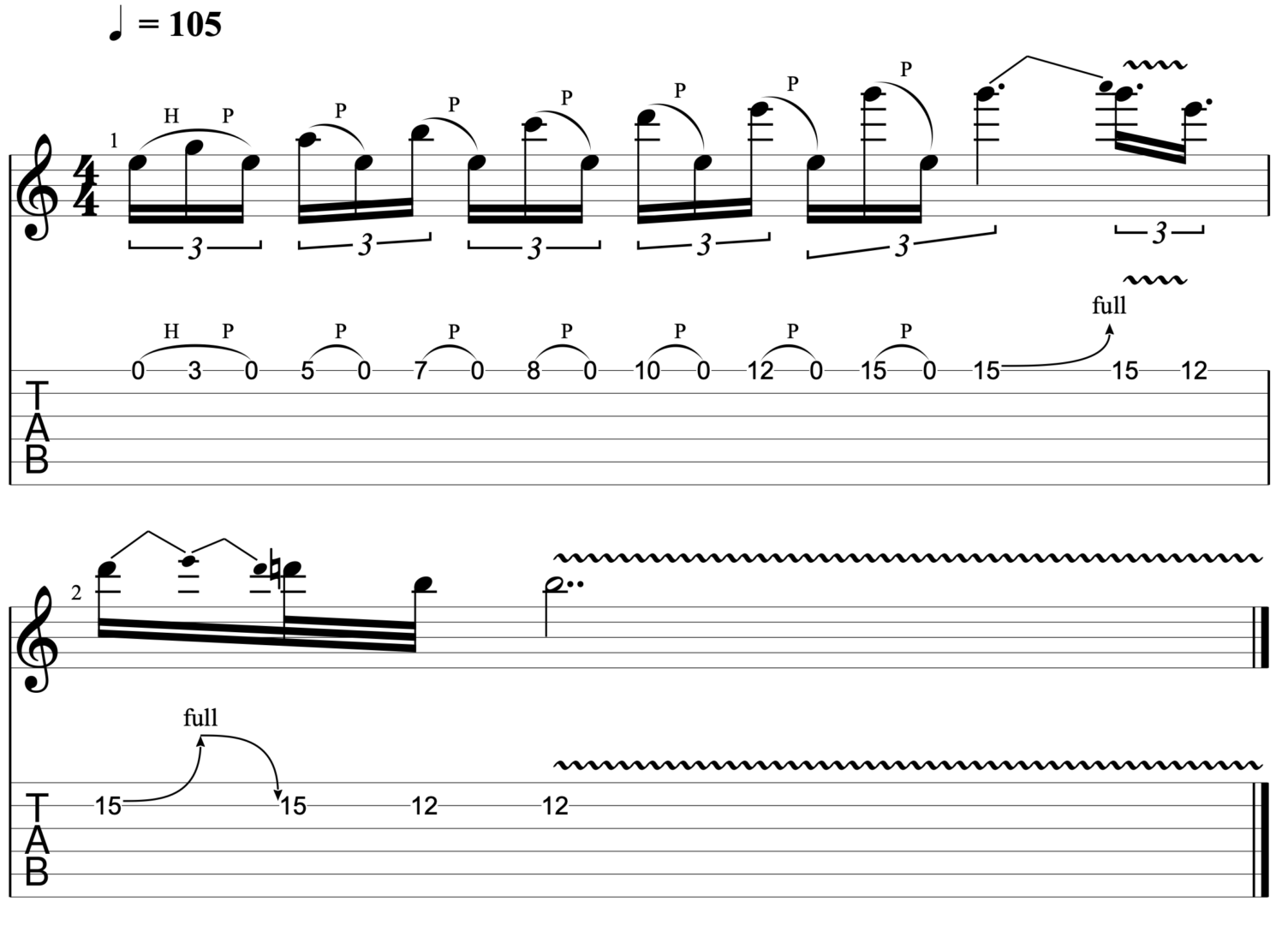Gary Moore is one of the most gifted and technically skilled guitarists in the history of the blues. He is also one of the most interesting.
Moore took the traditional form of the blues and fused it with heavy rock, shred guitar, and glam rock. In a totally unique way, he combined the core elements of the blues with these very different genres.
In doing so, he helped to revive the blues during the 1980s and ’90s.
He garnered praise from fans who had little knowledge or allegiance to the genre, and helped set the stage for modern guitarists like Joe Bonamassa.
From his philosophy to playing, to the gear he used, to the techniques that helped him craft his signature style – there is so much that you can learn from Gary Moore.
Studying Moore’s technique and how he created his tone will greatly improve your own playing and skills as a blues guitarist.
So without further ado, here are the 10 key lessons you can learn from Gary Moore:
1. Don’t break out of the box
The minor pentatonic scale defined the sound of Gary Moore’s lead playing. It was his ‘go-to’ scale and provided the foundation for the majority of his licks and solos.
This might sound obvious – as the minor pentatonic is unquestionably the most used scale in blues and rock music. Yet what Moore’s playing really highlights is just how much mileage you can get out of the scale.
Moore illustrates this point particularly well at the 2 minute mark of this video. Here he takes just 2 or 3 notes and shows how many licks he can create by altering his phrasing and articulation.
So many aspiring blues players try and ‘break out’ of the minor pentatonic scale shapes almost as soon as they learn them.
Yet as Moore points out in this video, it is crucial to get the basics right first. You don’t need to learn a whole range of complex and exotic scales to be a brilliant blues guitarist.
Moore used the minor pentatonic scale heavily in his playing, and yet his playing never sounds stale or boring. There are a number of reasons for this, which I have outlined in more detail below.
First things first though, don’t forget the importance of the pentatonic scale shapes. You can sound truly amazing and craft beautiful blues solos using nothing but the minor pentatonic scale.
2. Express yourself
One of the characteristics that made Gary Moore such a great guitarist was the sheer emotion that he put into his playing.
Moore was a famously expressive guitarist, with one of the most interesting and unusual ‘guitar faces’ in the history of blues and rock.
It is little surprise.
Moore played every note with intense feeling and emotion, and this is really the point that he is making in the video above.
You should learn how to play just one note with the right feeling. Once you have that nailed, you can then move on to look at other areas of your playing.
The emotion and feeling with which Moore played is evident in all of his songs. However it is particularly prominent in songs like ‘The Prophet’, ‘Still Got The Blues‘ and ‘The Messiah Will Come Again‘.
To recreate the same feeling in your playing, exaggerate your focus on every single note that you play.
Don’t treat notes carelessly.
Focus on them with real attention and try to express as much emotion as you can through your playing. It will do a huge amount to improve your skills as a blues guitarist.
3. Speed up
The other key element of Moore’s playing that makes it so effective, is his use of speed.
Moore is one of the fastest blues guitarists of all time and used fast licks a lot in his lead playing. In fact, it is very difficult to sound like Gary Moore without playing fast.
So if you want to learn from Gary Moore and emulate his playing, you need to be able to execute licks at speed.
Crucially, you need to be able to do this without sacrificing accuracy. For although Moore was very fast, he played with pin point precision.
There are a lot of different exercises that you can work on to get faster, which I cover in more detail in this article here.
One simple exercise to get quicker however is to play chromatically up and down your neck in time with a metronome, as follows:

At 80 BPM, this is what this exercise sounds like:
The idea here is to play 4 notes for each click of the metronome.
Don’t use any hammer ons or pull offs; pick each note individually. Work your way up the neck by moving up 1 fret every time you reach the high or low E string.
In the example above then , after playing the 2nd fret on the low E, you would move up 1 fret, and start the pattern again from the 3rd fret.
Go all the way up the neck until you hit the 15th fret, then work your way back down the neck to the beginning.
Start at a tempo that is comfortable. You should be able to play all the way up and down the neck, keeping time with the metronome and playing all of the notes with precision.
Once you can do that, up the tempo by 1 beat. Repeat the exercise until again you can play up and down the neck in time.
Include this exercise in your practice routine and over the course of weeks and months you will totally transform the tempo at which you can play.
4. Throw the hammer down
You can expand on and adapt the exercise above to improve the speed of your legato technique. For unlike Joe Bonamassa and Eric Johnson – some of the other notable bluesmen that play very fast – Gary Moore uses a lot of hammer ons and pull offs.
In fact it is really quite rare for Moore to pick every note when playing fast.
His fretting hand is often moving very quickly, whilst his picking hand is much less active.
Although this legato style of playing is easier on your picking hand, it poses a different challenge for your fretting hand.
You need to have the strength and dexterity to fret each note without picking, and to do so whilst keeping time and playing at speed.
The good news though, is that you can build your legato technique by simply making 1 adjustment to the exercise outlined above.
So instead of alternate picking every note, all you need to do is play each string once and use hammer ons and pull offs to fret the notes. This is what this exercise looks like in practice:

And at 80 BPM, this is what it sounds like:
As with the previous exercise, the idea here is to play 4 notes for each click of the metronome. Except here you are not picking each note individually. You are picking once for every set of 4 notes.
On the way from the bottom strings to the top, you use hammer ons. Then on the way down – from the top strings to the bottom – you use pull offs.
Like the previous exercise, work your way up the neck until you hit the 15th fret. Then work your way back down your neck to the beginning.
Start at a tempo that is comfortable and include the exercise in your practice routine until over time you can play it at a much faster tempo.
5. Shoot to trill
Once you have built up your legato technique, you can use it to emulate the fast trills that Gary Moore regularly includes in his solos.
This was one of his signature techniques and it is a great way to bring life to basic pentatonic shapes.
Moore uses this technique in a lot of different songs, but one obvious example is in the solo (at the 1.22 minute mark) of his cover of the Albert King song ‘Oh Pretty Woman‘.
This is one of the first licks that Moore plays in that solo:

Played at the 105 bpm of the original song, it sounds something like this:
This is an advanced lick. It is very fast and fiery, and it is not easy to play.
Even if this specific lick is too fast to add to your repertoire though, I hope it illustrates how you can include trills in your own playing.
The other way in which Gary Moore used trills to great effect, was by using open strings.
This is a technique that you can hear very clearly in the solo (at the 1.21 minute mark) of Moore’s cover of ‘Walking By Myself‘. It sounds amazing and is surprisingly easy to incorporate within your own playing.
Here is an example lick that I use quite a lot in my own playing:

At the same 105 BPM as the lick from ‘Oh Pretty Woman’, this is what this lick sounds like:
This is just one example, and there are hundreds of different ways you can incorporate this technique into your soloing.
Personally I like to use it to move between different pentatonic shapes. It keeps things interesting and combines quite a heavy rock sound with a more traditional blues soloing style.
Try incorporating this in your own playing to add variety to your improvisations.
6. Speed kills (a solo…)
Even though Gary Moore could hold his own with the fastest shredders out there, he always struck an amazing balance between playing at speed and playing with soul.
For although fast playing often sounds amazing, the blues is not about shredding. In fact, in my opinion there is a point at which fast pentatonic runs up and down the neck ceases to be musical.
Moore never let his ability to play fast compromise his ability to evoke emotion.
One of his most impressive skills was the way that he crafted solos that effectively combined slow, soulful licks with very fast pentatonic runs.
You can hear this a lot in Moore’s playing, but some great examples of guitar solos where Moore uses this technique are as follows:
- ‘One Day‘ (Starting at the 2.37 mark)
- ‘Still Got The Blues‘ (Starting at the 3.37 mark)
- ‘The Messiah Will Come Again‘ (The whole song is instrumental, but this technique is used particularly well at the 3.19 minute mark)
The way that he continually switches between slow, soulful bends and then fiery and fast licks keeps his solos varied and interesting.
It is part of what makes him such a brilliant guitarist and in my opinion, it is one of the most important lessons that you can learn from Gary Moore.
7. Soar like a bird
When he was not playing fast, part of what make Gary Moore’s soloing so effective is his bending technique.
He was truly amazing at hitting huge soaring bends that made his guitar sound like a human voice.
Not only that, but he was able to sustain those bends for great lengths of time.
If you haven’t yet heard it, I would strongly urge you to listen to the version of ‘Parisienne Walkways‘ that Moore performed at the Royal Albert Hall in 1993.
At the 2.11 mark he hits a beautiful bend which he sustains for almost 30 seconds!
I am not suggesting you need to sustain your bends for quite so long. However, Moore uses these beautiful, soaring bends a lot.
They add so much feeling and emotion to his solos, and make his playing sound amazing.
8. Go heavy
In my opinion, Gary Moore had one of the best blues rock tones of all time. Like his playing, it is fiery, powerful and intense, yet full of soul.
In comparison to most other blues players, it is also quite a heavy tone. Moore used a lot of gain and that really was a core part of his sound.
During his career, Moore played a whole range of different amps and guitars.
His core tone however came from a Gibson Les Paul plugged into a Marshall amp. Specifically, Moore played Peter Green’s legendary ‘Greeny’ Les Paul with its out of phase pickups, as well as a ’59 Les Paul.
He plugged this into either a Marshall 1959 Super Lead or a Marshall JTM45 and added a couple of key pedals into the mix. Most notably he used an Ibanez TS9 Tube Screamer, and a ‘Marshall Guv’nor distortion pedal.
When Moore was looking for a warmer tone, he played on his neck pickup. Then when he wanted to crank things up a notch or to play fast, he would typically switch and start playing on his bridge pickup.
I detailed all of the gear that Moore used to craft his signature tones in this article here.
However if you want to recreate Moore’s killer blues tone, a Gibson Les Paul or Epiphone replica Les Paul plugged into a Marshall tube amp will definitely set you on the right path.
9.) Vary your vibrato
One of the final elements that make Gary Moore’s playing sound so beautiful is his vibrato.
The quality and style of your vibrato makes a huge difference to your playing. Every guitarist adopts a slightly different technique, but within the blues, Gary Moore’s vibrato style is both brilliant and quite unusual.
Prior to the late 1980s, Moore had spent most of his career playing heavier forms of rock music, and this really influenced his vibrato technique.
Generally speaking, in rock music guitarists use a heavier and wider style of vibrato.
In other words, they move the string up and down a lot when they are applying vibrato, and they move their fingers in a wide arc.
Conversely, in blues a lot of players use a more gentle and restrained style of vibrato. They typically move the string in quite a subtle way, and move their fingers in a shallow arc when applying vibrato.
Gary Moore did both – a point you can see illustrated in this brilliant clip of Moore playing ‘The Messiah Will Come Again‘.
In the slower and more sedate passages of the song, Moore applies a more subtle and traditional style of vibrato.
Then as the song progresses, he moves to a heavier and wider style of vibrato, more commonly used in rock.
Altering his vibrato in this way really helps him to change the vibe and feeling in different parts of the song.
10. Develop your own voice
Part of what made Gary Moore such a brilliant blues guitarist was the way that he studied the genre and learnt from the early masters.
His influences included blues guitarists as diverse as B.B. and Albert King, Albert Collins and Peter Green.
In fact both Albert King and Albert Collins played on Moore’s album Still Got The Blues, and Gary Moore recorded Blues For Greeny – a whole album dedicated to his friend and mentor Peter Green.
Gary Moore studied these players and learnt from them. Crucially though, he blended their techniques and style with his own, to develop his own voice. As Moore said in his own words:
I started listening to all the blues guys, like B.B. King and Albert King. It still goes back to those guys, and I think my playing is a combination of all of those elements, but at some point it came together and became my own style
That is a brilliant way to approach your own playing.
You want to study and learn from as many different guitarists and musicians as possible, without simply copying their style.
Try to develop your own voice. This is what Gary Moore did, and he developed an amazing style unique to him.
It is not easy to do this, but focus on trying to make it happen. You will greatly improve as a musician and it will make your guitar playing journey much more enjoyable.
Images
Feature Image – Olivier Bourgi (Flickr) – The License for the image is here
Image of Peter Green – Nick Contador (Wikimedia Commons) The License for the image is here.
References
Youtube, Guitar World, Youtube, Vintage Guitar Magazine, Youtube, Guitar World, Music Radar, Guitars Exchange, Youtube





Responses
“That is a brilliant way to approach your own playing. You want to study and learn from as many different guitarists and musicians as possible.”
Couldn’t agree more!
Thanks so much Julien – I hope you’re enjoying listening to Moore, and that you can use some of the tips outlined here in your own playing!
I think Messiah from his first Montreax is probably his best ever recording.
Moore really had only few techniques, but he played them with a great articulation, and this made all the difference. That is also why nobody can imitate him.
Note that his hammer ons/pull offs are mostly made using the second finger, that’s not too convenient for most people. But using this finger made the articulation we were all looking for.
Also, Moore was around since the late 60s, so from the beginning. He has seen what gear all the great guys were using, from Gallagher to Green, and later van Halen. He always had good skills, but he really matured technically in 80s, probably after short stay in Los Angeles, and contact with heavy metal shredders over there.
Thanks so much for the comment Lukasz and for sharing that interesting information! I absolutely agree with you on the recording of Messiah from Montreux. It’s one of my favourite instrumentals and one which I feel really showcases the depth of Moore’s talent and his amazing control over the instrument. When I look at him playing clips of that song and others, I do still find it quite strange to see him blazing those searing runs with just his first and middle fingers, but as you say, it gives his playing a certain feel and articulation and adds to the magic! 😁
I have really studied Gary Moore for about three months solid. I have mostly listen to him only for about that time. I have to say he has one of my favorite tones. I’ve heard it said Gary played Blues like ” a bull in a china shop.” That sums it up perfect !
I think what makes him different versus most blues guys is his Hard Rock and Metal background . He stayed true to himself and added that to Blues. If you get a chance listen to him play Stormy Monday and “The Sky is Crying” . One of my favorites he plays is ” Did you ever feel lonely.” It’s a clinic in emotion and Blues Rock he has some of the meanest bends with vibrato and double stops in there.
Thank you so much for sharing Earl and you are absolutely right! Moore mixes his influences in a unique and interesting way, and his tone and playing are just unbelievable. He is one of my favourite players of all time, and so I am very glad to hear that you are enjoying his playing so much too! 😁